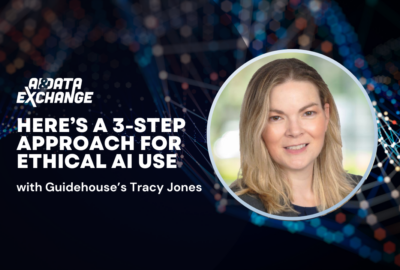Hubbard Radio Washington DC, LLC. All rights reserved. This website is not intended for users located within the European Economic Area.
AI & Data Exchange 2024: State’s Matthew Graviss, NIH’s Susan Gregurick on AI as force multiplier
The State Department and National Institutes of Health reap diplomatic, scientific benefits from leaning into artificial intelligence.
The State Department and National Institutes of Health plan to continue investing in and adopting artificial intelligence tools to meet their missions while also gaining better insight from their data in an increasingly interconnected world.
State considers AI as “an inevitable tool in the toolbox of diplomacy,” said Matthew Graviss, the department’s chief data and AI officer. As such, State is taking steps to install guardrails to ensure responsible use of the technology.
NIH is on a similar path, said Susan Gregurick, associate director for data science and director of the Office of Data Science Strategy. “We are working to ensure that new innovations in trustworthy AI — and the approaches that would reduce bias and risks — are fundamentally funded in biomedical research, as well as looking at making data fair, validating models and providing explainable AI algorithms.”
Graviss and Gregurick shared snapshots of their agencies’ current AI strategies and uses for a panel discussion during Federal News Network’s AI and Data Exchange .
Adopting AI to reimagine diplomacy
Using AI smartly for diplomacy makes sense in the current world order, said Graviss.
“There’s a strong demand for seeing opportunities and taking advantage, where we can, to use it responsibly. The world that we live in right now is more interconnected than anywhere at any time. And that shows up in diplomacy,” he said. “More of today’s diplomatic challenges are borderless. They’re global — like climate, for example. That’s a global challenge.”
Issues such as climate change are not specific to a one particular country engaging with the United States on just one particular topic. “It’s an interconnected world, and that requires our diplomats to have regional and global context, even when engaging bilaterally,” Graviss said. “We see generative AI as an opportunity to create a big advantage when it comes to synthesizing a large amount of information.”
The department released its first-ever enterprise AI strategy in November 2023, soon after the Biden administration released its sweeping executive order on stepping up the use of AI tools in government.
“We took an all-of-department approach to developing the strategy. We had several bureaus across the Department of State participate in that process, to ensure that we were factoring in elements like privacy and cybersecurity and legal considerations,” said Graviss, who leads the department’s AI Steering Committee. It’s focused on legal, privacy and security, as well as evaluating necessary AI policy and guardrails.
The State AI strategy focuses on four areas:
- Secure infrastructure
- Culture
- Responsible AI adoption
- Innovation
Graviss pointed out that much of the work around culture depends on employees sharing their AI success stories across the department.
“Analysis without communication helps one person — literally. If you don’t share what you’re doing and how you’re doing it, you’re only helping one person,” he said. “This culture-building activity of how these tools, when safely used, can streamline our operations as an agency and enhance diplomatic outcomes is really important.”
Lowering barriers to medical research through AI
NIH is working on multimodal AI that’s trained on data that ranges from medical records and medical imaging to wearable sensor data and genomics data, said Gregurick, who leads data science and AI work across NIH’s 27 institutes, centers and offices.
“Multimodal AI has the potential to improve prediction and provide new insights into very complex biomedical systems,” she said. “Multimodal AI is really geared towards very complex, multidimensional integrated systems that all of these data are coming from.”
NIH is pursuing an ethics-first approach to multimodal AI in biomedicine and is taking steps to ensure the AI tools produce ethical and equitable results, she said. “When we’re thinking about new activities for AI and new approaches to funding research in AI, this is something that we will be pushing out.”
NIH is also supporting the federal government’s efforts to make AI resources more accessible to a broader community of researchers. The agency is contributing data sets to the National AI Research Resource (NAIRR), a hub of federal AI research resources.
By lowering the barriers to participation in AI research and allowing more researchers to get involved in AI development, the Biden administration expects the research community will be better equipped to tackle emerging challenges around ethical AI use.
“We are contributing a very large number of high-quality datasets and imaging in immunology and cancer, multiple chronic diseases and data derived from health care encounters,” Gregurick said.
NIH is partnering with the Energy Department on a NAIRR Secure pilot to give researchers access to data derived from NIH health care and clinical imaging encounters, while keeping the data secure.
The agency also is recruiting data scientists and AI computer scientists through its Data Scholar Program. The program brings experts from academia, industry, nonprofits and other federal agencies for a two-year sabbatical at NIH to lead innovative research.
And through its AIM-AHEAD program, it is looking to advance health equity and promote diversity in the researchers who are developing and using AI tools.
“When you think about AI and NIH, think about trustworthy, fair, unbiased AI that’s reaching as broad a community as possible,” Gregurick said.
She noted that the administration’s AI executive order called on NIH to increase and expand the AIM-AHEAD program.
“You’ll see more opportunities for students, everyone really — from junior high up through tenured professors — to get their hands on and participate in artificial intelligence through the AIM-AHEAD program, as well as developing capacity and capabilities at underrepresented, underserved institutions,” Gregurick said.
Viewing generative AI as a ‘true force multiplier’
Among the State Department’s uses of generative AI, Graviss said the technology can help diplomats quickly make sense of the local news that’s being produced in the countries and regions where they’re stationed.
“We have a responsibility for understanding what’s going on in a particular post. If you work in Tashkent, or you work in Tegucigalpa, you need to understand what’s happening in the local media environment. It’s kind of hard to clean other people’s data, but if you can contribute to a generative AI tool the media articles that are most relevant to you — and you ask it to summarize it and limit the answers to what you’re feeding it — that can be super valuable and a major time savings,” Graviss said.
“The spoken word is the currency of the State Department, and so we can see generative AI as a true force multiplier. … We want our diplomats spending more face-to-face time and less time face-to-screen,” he said. “We want them out engaging and less time writing about it, and this can help. Generative AI can help in a fairly significant way.”
NIH uses AI at its National Institute of General Medical Sciences to match research applications for funding to program officers. The institute receives well over 20,000 applications every year but only about 4,000 receive funding, Gregurick said.
“Matching an application to a program officer at that institute can be quite a lot of time-intensive labor,” she said.
The institute uses AI to pull information for the title and body of a grant abstract, then uses that information to assign the application to the most appropriate program officer. “It allows us then to just narrow down on the workload that our staff would have to do in order to actually just decide, ‘Is this application going to be within the scientific expertise of this program officer?’ ” Gregurick said.
‘Elevating the skills’ of the workforce
Among his duties, Graviss also leads the department’s Center for Analytics, which serves as a central hub for all of State data and AI capabilities. The department recently ramped up its data for diplomacy efforts by naming chief data officers to each of its component bureaus and offices.
“We’ve taken this campaign approach … taking one foreign policy challenge, one management challenge [and] going as fast as possible in six months — elevating the skills of the people in those areas, delivering value quickly and coming up with sustainable solutions — such that the Center for Analytics as a hub can pivot to the next two priorities,” Graviss said.
After two years of work, the center is on track to complete 16 campaigns tied to mission-critical areas, such as strategic competition, workforce diversity, cybersecurity and multilateralism, he said.
“Each of these areas will be leveled up with the use of data and AI,” Graviss said. “I think it’s a model that’s proven really successful.”
Discover more articles and videos now on our AI & Data Exchange event page.
Copyright © 2024 Federal News Network. All rights reserved. This website is not intended for users located within the European Economic Area.
Jory Heckman
Jory Heckman is a reporter at Federal News Network covering U.S. Postal Service, IRS, big data and technology issues.
Follow @jheckmanWFED
Related Stories
AI & Data Exchange 2024: DARPA’s Kathleen Fisher on prepping for AI’s future through high-risk, high-reward research
AI & Data Exchange 2024: Guidehouse’s Tracy Jones on 3-step plan for effective and ethical AI
Related Stories
-
AI & Data Exchange 2024: Sen. Mark Warner on creating AI guardrails Artificial Intelligence
-
AI & Data Exchange 2024: Guidehouse’s Tracy Jones on 3-step plan for effective and ethical AI Artificial Intelligence





